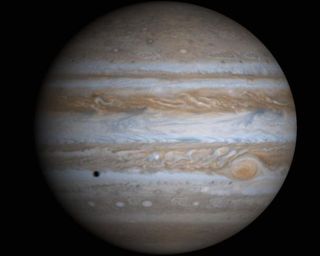The Greatest Mysteries of Jupiter

Each week this summer, Life's Little Mysteries, a sister site to LiveScience, presents The Greatest Mysteries of the Cosmos, starting with our solar system.
The planet Jupiter rightly gets its name from the king of the gods in Roman mythology: As the biggest planet, Jupiter lords over the rest of our solar system. The bloated world is so big, in fact, that if all the other objects in the solar system (excluding the Sun) were mashed together, they would all fit inside the sphere of Jupiter.
Matching Jupiter's gargantuan size are its many huge scientific mysteries. In early August, NASA will launch the next major Jupiter mission, called Juno, a spacecraft that will rendezvous with Jupiter in 2016 and help shed light on the planet's greatest mysteries, which include:
Cloud bands and storms
Jupiter looks like a carefully dyed Easter egg. Lighter-hued bands, called zones, and darker ones, called belts, gird the massive world. Just how deep these features go, however, is entirely uncertain.
"We don't know if the beautiful zones and belts are just a surface feature, and on the inside Jupiter's rotating like a solid body," said Scott Bolton, principal investigator for the Juno mission and director of the space science and engineering division at the Southwest Research Institute in San Antonio, Texas.Alternatively, Jupiter could be"a series of concentric cylinders and you're seeing the tops of those pop out as zones and belts," Bolton told Life's Little Mysteries.
Whole stripes have been known to disappear without a trace; one vanished in May 2010 that was twice as wide as Earth. Why bands stay separate and come and go is not well explained, nor even how the zones and belts get their distinctive colors. [Read: How Much Would You Weigh on Jupiter?]
Sign up for the Live Science daily newsletter now
Get the world’s most fascinating discoveries delivered straight to your inbox.
Great vortices swirl in Jupiter's atmosphere, but these too are not well understood. The Great Red Spot is the most-recognized of these tempests, having been observed for more than 300 years. "We don't know what's powering that thing," Bolton said.
Juno will gather temperature measurements from all over the gas giant to help inform our patchy atmospheric models.
Where's the water?
Along with Saturn, and the vast majority of exoplanets detected thus far, Jupiter is classified as a gas giant. That's mostly what the world is: A great ball of hydrogen and helium gas, the two most common elements in stars and the universe. Most of the leftovers from the sun and the solar system's formation ended up in Jupiter.
Yet the amounts of heavier elements, such as carbon, nitrogen and sulfur, also floating amongst Jupiter's clouds strangely exceed those found in the Sun. Scientists think that water in Jupiter's atmosphere might have helped enrich the planet with these elements. As water freezes, it captures stray materials, and Jupiter could have gobbled up lots of these element-enriched chunks.
But the trouble is, water has not been found in the expected concentrations, Bolton said. Juno will look for water's signature to help explain why Jupiter has its distinctive composition. [Read: Where Did Earth's Water Come From?]
Learning that, in turn, will speak to how the solar system's smaller bits came to be.
"Juno's primary goal is to understand the fundamentals of how the solar system formed and how the planets were made," Bolton said. "We're trying to figure out the recipe for making planets, and we're back at the ingredients list."
A "core" issue
Researchers think Jupiter might have a core of sorts, perhaps made of superheated rock under high pressure, but the jury is decidedly out. [Read: How Hot Is the Center of the Earth?]
"The models don't constrain [the core's mass] at all," said Bolton. "It could be zero, it could be twenty earth masses, and that's because of a lack of data."
Juno will help fill in the blanks by taking gravity field measurements, which speak to the distribution of mass deep inside Jupiter.
Bonus boggler: Heckuva light show
Jupiter possesses the strongest magnetic field in the solar system, excepting the sun's. Researchers think the field is generated by a highly compressed layer of hydrogen, which develops liquid metallic properties, deep in Jupiter.
The structure that this magnetic field forms — called a magnetosphere — as the "solar wind" of charged particles from the sun stream past is truly titanic.
"Jupiter's magnetosphere is arguably the largest structure in the entire solar system," said Bolton, "other than the heliosphere" — the solar wind-blown bubble surrounding the Sun. "[Jupiter's magnetosphere] gets dragged out windsock-fashion all the way out to Saturn's orbit."
Auroras — like our Northern and Southern Lights, though immensely more powerful and with notably different characteristics — glow at Jupiter's poles. Juno, which will circle the planet in a polar orbit, will have a great view, helping tease out the mechanisms that drive Jupiter's magnetic maelstroms.
This story was provided by Life's Little Mysteries, a sister site to LiveScience. Follow Life's Little Mysteries on Twitter @llmysteries, then join us on Facebook.
